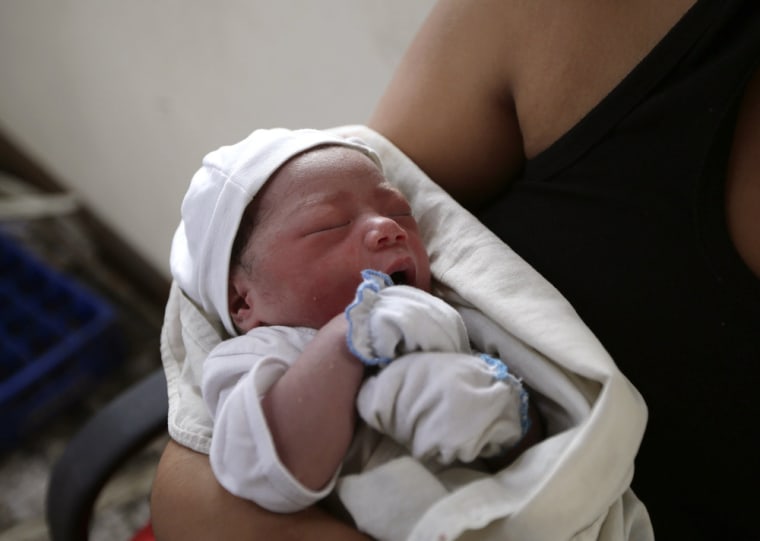Stories of survival and perseverance — some miraculous, each heartbreaking in its own way — are emerging from the typhoon-wrecked islands of the Philippines.
On the third day after the storm, perhaps the most powerful ever to strike land, cheers arose at what was left of an airport when a 21-year-old woman gave birth to what quickly has become known as the Miracle Baby.
The child was born at what passed for an emergency clinic, amid shards of glass from the air-traffic tower and overturned cars. She was named Beatriz Joy Sagales, after her grandmother, who was among the thousands still missing.
The new mother, Emily Ortega, had to swim and cling to a post to survive, The Associated Press reported. Ortega was at an evacuation center when the Typhoon Haiyan flooded the city of Tacloban.
Ortega’s husband was in the safety of the capital, Manila, about 360 miles away. The airport in Tacloban was all but swept away. Efren Nagrama, a manager there, told Reuters that the water reached 13 feet.
‘Let go. Save yourself’
A high school teacher told of watching the last moments of her daughter’s life and hearing her unforgettable last words: “Ma, just let go. Save yourself.”
The teacher, Bernadette Tenegra, told a Filipino newspaper that she was huddled with her family in their shanty, figuring that it might hold out through the storm, as it had before.
But water swamped the home with incredible speed, and the family was swept away. Tenegra, 44, said that her husband and one of her daughters scrambled to safety. But the younger daughter was caught in the current.
“I crawled over to her, and I tried to pull her up,” Tenegra told the Philippine Daily Inquirer through tears. “But she was too weak. It seemed she had already given up.”
Then came those last words, the mother said. “And then I just let go.”
For one man, saving lives is ‘the mission’
For Manuel Araneta Roxas, this is a time for small victories.
“Mar,” as he is known to his people, is the secretary of interior and local government in the Philippines. He has taken charge of the relief operation in the central Visayas, which took the brunt of the storm’s force.
He is working around the clock, monitoring the attempted movement of food, water and medical supplies into the “kill zone.” So far there is little to show for his work. The good news on Monday was that a cell site was back up in Tacloban.
“That means at least some people can communicate again,” he said.
In just the past year, the Philippines has been hit by 24 cyclones and a 7.2-magnitude earthquake. Last December, another super-typhoon, called Bopha, left more than 600 dead and an estimated $1 billion in damage.
Roxas learned from that storm, and his hands-on approach to disaster has led some people in Manila to consider him a candidate for president in 2016. For the moment, though, he is focused on his work.
Asked by an NBC News reporter whether American TV could jump on one of his helicopters and follow him around, he said: “I can’t promise you anything. We’re filling up our aircraft with food and blankets and trying to save lives. You understand — that’s the mission.”
Clinging to survival
Jean Mae Amande said that she was washed miles from her home when a surge of water hit Tacloban, a city of 200,000. She said she watched an old man die — they were both swimming for their lives when an iron roof sliced his neck.
Amande, 22, told Reuters that the current ripped her out to sea before pushing her back to shore. She managed to cling to a tree for a while, and find safety when she was thrown a rope from a boat.
“It’s a miracle,” she said, “that the ship was there.”
Laughter amid the ruins
For some in Tacloban, their very survival was all they had left. Against a backdrop of tangled timber and floating bodies, stilts where fishing huts once stood, a group of woman sat together Monday, found a laugh and said, “Still smiling — no house!”
Raya Almacera, eight months pregnant, made it out alive. Her house was one of the few in the city made of concrete, and her fathered sheltered there, but it was not enough to save him.
“We’re not able to save our father. It’s very sad,” she said, in accented English. “When the water hits, they all fall down and they all died.”
Born atop the rubble
The so-called Miracle Baby was not the only case of new life amid vast death. Riza Jaro, 18, gave birth after she and her family happened on a group of military rescuers with a folding bed.
Before the storm, she told the Inquirer, she couldn’t find a hospital to admit her for the upcoming delivery.
A member of the military corps put the folding bed on top of a pile of mud-caked papers and gave her dextrose. She was taken on a C-130 military plane to the city of Cebu to give birth.
Jaro plans to name the child Yoonadale — similar to Yolanda, the Filipino name for the storm.
ITN's Angus Walker contributed to this report.
